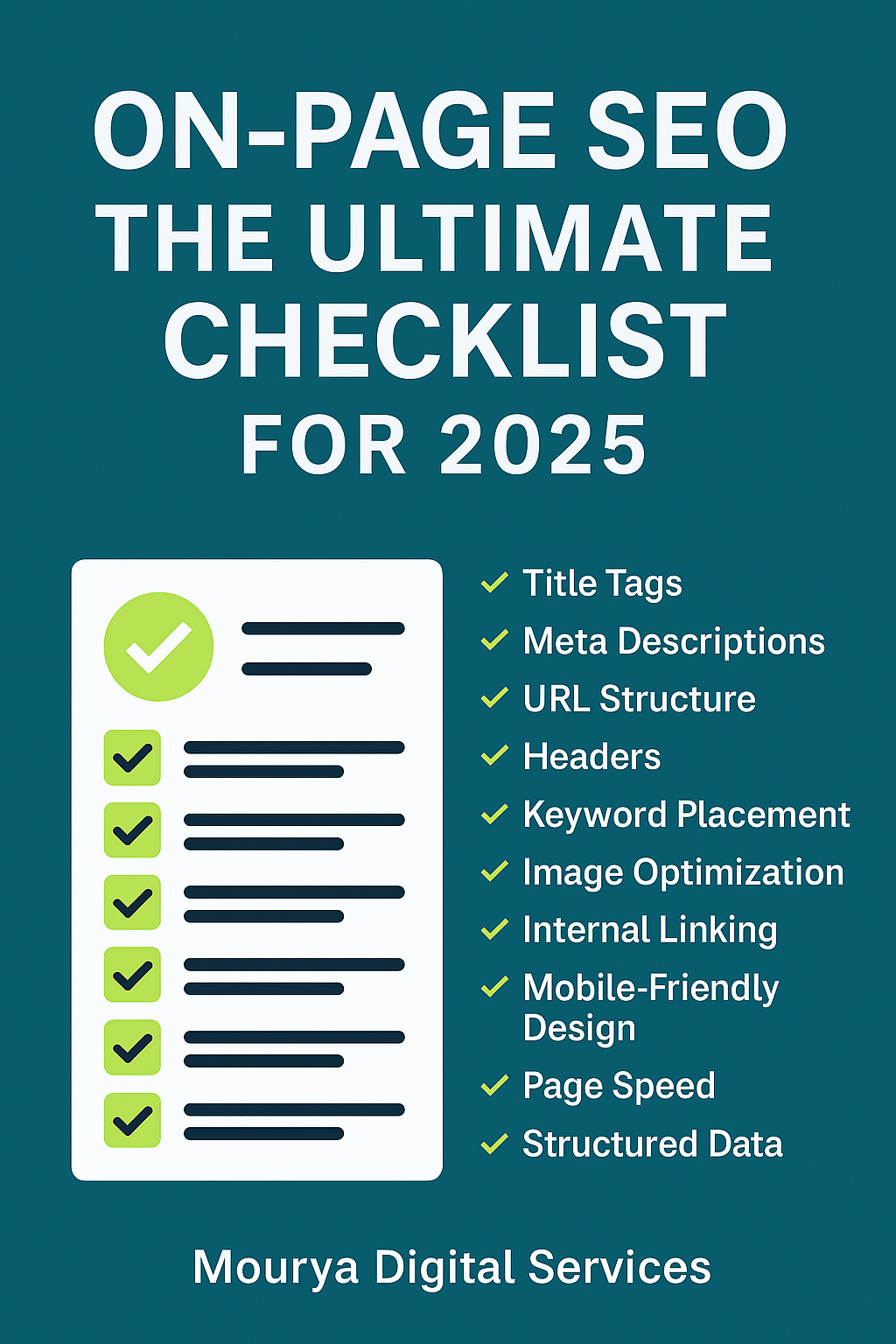
By Mourya Digital Services
In the digital age, your website is your most valuable business asset. But simply having a website isn’t enough — it needs to be visible, fast, and optimized for both users and search engines. This is where On-Page SEO comes in. It’s the foundation of any successful SEO strategy.
At Mourya Digital Services, we’ve helped businesses across industries improve their rankings and drive traffic using a solid on-page SEO framework. This blog shares our ultimate on-page SEO checklist for 2025 — so you can do the same.
🧠 What is On-Page SEO?
On-Page SEO refers to optimizing individual pages on your website to rank higher and earn more relevant traffic in search engines. It includes content, HTML source code, meta data, internal linking, and UX elements.
It’s different from off-page SEO, which focuses on backlinks and external signals. On-page SEO is fully under your control — and that makes it crucial to get right.
✅ The Ultimate On-Page SEO Checklist
Here’s everything you need to cover in 2025 for perfect on-page optimization:
1. Title Tags — The First Impression
- Keep it under 60 characters.
- Include your primary keyword near the beginning.
- Make it compelling enough for clicks.
- Avoid duplicate title tags across pages.
✅ Example:
Wrong: Home — Mourya Digital Services
Right: On-Page SEO Services in India | Mourya Digital Services
2. Meta Descriptions — Improve CTR
- Length: 150–160 characters.
- Use power words + your primary keyword.
- Should match the page content.
- Unique for every page.
✅ Example:
“Boost your website traffic with expert on-page SEO services by Mourya Digital Services. Customized strategies for higher rankings.”
3. URL Structure — Keep it Clean & SEO-Friendly
- Use short, readable URLs.
- Include keywords.
- Avoid unnecessary parameters or numbers.
✅ Example:
Bad: www.mouryadigital.in/page?id=27834
Good: www.mouryadigital.in/on-page-seo-checklist
4. Use of Headers (H1-H6)
- Use one H1 per page.
- Use H2, H3 for subheadings and structure.
- Include keywords naturally.
- Makes content skimmable and accessible.
✅ Tip: Google uses headers to understand the content hierarchy.
5. Keyword Placement — Smart & Natural
- Primary keyword in:
- Title tag
- First 100 words
- H1 and at least one H2
- Image alt text
- URL (if possible)
But avoid keyword stuffing. Write for humans first, search engines second.
6. Image Optimization
- Use descriptive file names and alt text.
- Compress images for fast loading (use WebP or AVIF).
- Add captions if needed.
✅ Tip: Optimized images improve SEO and accessibility.
7. Internal Linking Strategy
- Link to relevant pages within your website.
- Use descriptive anchor text.
- Helps spread link equity and improves crawling.
✅ Example:
Want to improve local SEO? Read our GMB optimization guide.
8. External Linking — Add Authority
- Link to credible sources (news sites, research, tools).
- Opens doors for backlink opportunities.
- Shows Google you’re providing value.
✅ Rule: Make sure external links open in a new tab and add rel="nofollow" where necessary.
9. Mobile-Friendly Design
Google prioritizes mobile-first indexing.
- Use a responsive layout.
- Avoid popups that block content.
- Test on multiple devices.
🔧 Use Google’s Mobile-Friendly Test Tool
10. Page Speed Optimization
- Ideal load time: Under 2.5 seconds.
- Use caching, lazy loading, and CDN.
- Compress CSS, JS, HTML.
🔧 Tool: PageSpeed Insights
11. Structured Data (Schema Markup)
- Add schema for:
- Articles
- Products
- Reviews
- FAQs
This enhances your listings with rich snippets.
✅ Bonus: Higher CTR on Google.
12. Content is King — Write for Users
- Minimum: 600+ words per page.
- Target user intent (informational, transactional, etc.).
- Avoid thin or duplicate content.
- Use bullet points, FAQs, and tables to enhance readability.
✅ Tip: Use tools like SurferSEO or Frase for content scoring.
13. User Experience (UX)
- Clear CTA (Call-To-Action)
- Easy navigation
- No intrusive ads
- Breadcrumbs
- Proper font size and spacing
Happy users = lower bounce rate = higher rankings.
14. Canonical Tags — Avoid Duplicate Content Issues
If you have similar or duplicate pages, use canonical tags to tell Google which version is primary.
✅ Especially important for e-commerce, filters, or pagination.
15. Content Updates & Freshness
- Update old blogs with new data.
- Re-publish evergreen content.
- Monitor keyword shifts and adjust.
Google loves fresh, updated content — even on older pages.
16. SEO Plugins & Tools
If you’re on WordPress:
- Use Rank Math or Yoast SEO
- Monitor site health with Google Search Console
- Track rankings with SEMRush or Ubersuggest
🎯 Final Thoughts
On-page SEO isn’t a one-time task — it’s an ongoing process. Each element from this checklist works together to help Google understand your page, rank it correctly, and give users the best experience possible.
At Mourya Digital Services, we specialize in crafting SEO strategies that combine technical precision with content excellence. Whether you’re running a blog, e-commerce store, or a corporate website, following this checklist can drastically improve your visibility, traffic, and conversions.
📞 Contact Mourya Digital Services
📍 Serving Clients Across India | 💼 100+ Projects Delivered
🌐 https://mdsdigitalmarketing.online/ | ✉️ arpitak9810@gmail.com